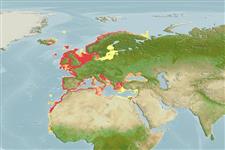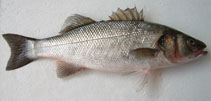Dicentrarchus labrax (Linnaeus, 1758)
European seabass
個人による観察記録の追加 Fish Watcher
| Native range | All suitable habitat | Point map | Year 2050 |

|
| This map was computer-generated and has not yet been reviewed. |
| Dicentrarchus labrax AquaMaps Data sources: GBIF OBIS |
Morocco country information
Common names:
[No common name]
Occurrence: native
Salinity: brackish
Abundance: | Ref:
Importance: | Ref:
Aquaculture: commercial | Ref: FAO, 1997
Regulations: | Ref:
Uses: no uses
Comments:
National Checklist:
Country Information: https://www.cia.gov/library/publications/resources/the-world-factbook/geos/mo.html
National Fisheries Authority:
Occurrences: Occurrences Point map
Main Ref: Bauchot, M.-L., 1987
National Database:
Occurrence: native
Salinity: brackish
Abundance: | Ref:
Importance: | Ref:
Aquaculture: commercial | Ref: FAO, 1997
Regulations: | Ref:
Uses: no uses
Comments:
National Checklist:
Country Information: https://www.cia.gov/library/publications/resources/the-world-factbook/geos/mo.html
National Fisheries Authority:
Occurrences: Occurrences Point map
Main Ref: Bauchot, M.-L., 1987
National Database:
Common names from other countries
分類 / Names 共通名の | 類義語 | Catalog of Fishes(部類, 種) | ITIS | CoL | WoRMS | Cloffa
> Eupercaria/misc (Various families in series Eupercaria) > Moronidae (Temperate basses)
Etymology: Dicentrarchus: Greek, di = two + Greek, kentron = sting + Greek, archos = anus (Ref. 45335).
More on author: Linnaeus.
Etymology: Dicentrarchus: Greek, di = two + Greek, kentron = sting + Greek, archos = anus (Ref. 45335).
More on author: Linnaeus.
Environment: milieu / climate zone / depth range / distribution range 生態学
海; 新鮮な水; 汽水性の 底生の; 海洋回遊性; 深さの範囲 10 - 100 m (Ref. 9987). Subtropical; 8°C - 24°C (Ref. 4944); 72°N - 11°N, 19°W - 42°E (Ref. 54221)
分布 国々 | 国連食糧農業機関の区域 | エコシステム | 事件 | Point map | 導入 | Faunafri
Eastern Atlantic: Norway to Morocco, the Canary Islands and Senegal. Also known from the Mediterranean and Black Sea. Absent from White, Barents, Baltic and Caspian Seas (Ref. 59043).
Length at first maturity / サイズ / 重さ / 年齢
Maturity: Lm 36.1, range 23 - 46 cm
Max length : 103 cm TL オス/雌雄の選別がない; (Ref. 40637); common length : 50.0 cm TL オス/雌雄の選別がない; (Ref. 6916); 最大公表体重: 12.0 kg (Ref. 1468); 最大記録サイズ: 30 年 (Ref. 59043)
Max length : 103 cm TL オス/雌雄の選別がない; (Ref. 40637); common length : 50.0 cm TL オス/雌雄の選別がない; (Ref. 6916); 最大公表体重: 12.0 kg (Ref. 1468); 最大記録サイズ: 30 年 (Ref. 59043)
簡単な記述 検索表 | 形態学 | 形態計測学
背面の脊椎 (合計) : 8 - 10; 背鰭 (合計) : 12 - 13; 肛門の骨: 3; 臀鰭: 10 - 12. Diagnosis: head with cycloid scales above; mouth moderately protractile (Ref. 231). Vomerine teeth only anteriorly (Ref. 231), in a crescentic band (Ref. 231, 57391). Scales on interorbital space cycloid (Ref. 57391). Posterior edge of opercle finely serrated, lower edge with strong forward- directed denticles (Ref. 231). 2 flat opercular spines (Ref. 231, 57391). Young with some dark spots on upper part of body (Ref. 231).
Adults manifest demersal behavior, inhabit coastal waters down to about 100 m depth but more common in shallow waters (Ref. 54221, 57391). Found in the littoral zone on various kinds of bottoms on estuaries, lagoons and occasionally rivers. They enter coastal waters and river mouths in summer, but migrate offshore in colder weather and occur in deep water during winter in the northern range. Young fish form school, but adults appear to be less gregarious (Ref. 9987). Feed chiefly on shrimps and mollusks, also on fishes (Ref. 5990). Juveniles feed on invertebrates, taking increasingly more fish with age. Adults piscivorous . (Ref. 59043). Spawn in batches (Ref. 51846). Spawning takes place in the spring near the British Isles, and earlier in its southern range. Eggs are pelagic (Ref. 35388). Marketed fresh or smoked (Ref. 9987). Highly sought by sport fishermen (Ref. 30578).
Life cycle and mating behavior 成熟 | 繁殖 | 放精 | 卵 | 生産力 | 幼生
Spawn in groups. Eggs are pelagic. In the Mediterranean, first sexual maturity occurs generally between 2 and 4 years of age while in the Atlantic sexual maturity happens a little later (males between 4-7 years and females between 5-8 years). Spawning happens just once a year and it tends to be in winter, although in southern areas it can occur in spring. Eggs have 1-2 fat drops that fuse about 12 hours after laying. Embryo development lasts about three days at 13-14°C and larval development about 40 days at 19°C. Egg size 1.1-1.5 mm, larval length at hatching 3 mm.
主な参考文献
Upload your references | 参考文献 | コーディネーター : Heemstra, Phillip C. | 協力者
Smith, C.L., 1990. Moronidae. p. 692-694. In J.C. Quero, J.C. Hureau, C. Karrer, A. Post and L. Saldanha (eds.) Check-list of the fishes of the eastern tropical Atlantic (CLOFETA). JNICT, Lisbon; SEI, Paris; and UNESCO, Paris. Vol. 2. (Ref. 6916)
IUCNのレッドリストの状況は (Ref. 130435: Version 2024-2)
絶滅危惧に近い (NT) (Near Threatened); Date assessed: 03 March 2022
人間に対する脅威
Harmless
Human uses
水産業: 商業; 水産養殖: 商業; ゲームフィッシュ: はい
より多くの情報
Population dynamics
成長のパラメーター
Max. ages / sizes
Length-weight rel.
Length-length rel.
体長組成
Mass conversion
補充
豊度
成長のパラメーター
Max. ages / sizes
Length-weight rel.
Length-length rel.
体長組成
Mass conversion
補充
豊度
Physiology
Body composition
Nutrients
酸素消費
水泳形態
泳ぐ速さ
Visual pigments
Fish sound
Diseases & Parasites
Toxicity (LC50s)
Body composition
Nutrients
酸素消費
水泳形態
泳ぐ速さ
Visual pigments
Fish sound
Diseases & Parasites
Toxicity (LC50s)
用具
E-book | 野外観察図鑑 | 検索表 | Length-frequency wizard | 生活史の基盤ツール | 目的のマップ | Classification Tree
| Catch-MSY |
特記事項
XMLをダウンロードして下さい
インターネットの情報源
Alien/Invasive Species database | Aquatic Commons | BHL | Cloffa | Websites from users | Check FishWatcher | CISTI | Catalog of Fishes(部類, 種) | DiscoverLife | DORIS | ECOTOX | Faunafri | Fishtrace | GenBank(ゲノム, ヌクレオチド) | GloBI | GOBASE | | Google Books | Google Scholar | Google | IGFA World Record | MitoFish | 国のデーターベース | OsteoBase(skull, spine) | Otolith Atlas of Taiwan Fishes | 公共の水族館 | PubMed | Reef Life Survey | Scirus | SeaLifeBase | 生命の木 | Wikipedia(行く, 検索する) | World Records Freshwater Fishing | 動物に関する記録
Estimates based on models
Preferred temperature (Ref. 115969): 7.3 - 19.5, mean 10.7 (based on 788 cells).
Phylogenetic diversity index (Ref. 82804): PD50 = 0.7656 [Uniqueness, from 0.5 = low to 2.0 = high].
Bayesian length-weight: a=0.00933 (0.00780 - 0.01117), b=3.02 (2.97 - 3.07), in cm Total Length, based on LWR estimates for this species (Ref. 93245).
栄養段階 (Ref. 69278): 3.5 ±0.50 se; based on food items.
回復力 (Ref. 120179): 手段, 1.4年~4.4年の倍増期間の最小個体群 (K=0.06-0.33; tm=2-8; tmax=30; Fec=230,000).
Prior r = 0.37, 95% CL = 0.25 - 0.56, Based on 10 full stock assessments.
Fishing Vulnerability (Ref. 59153): High to very high vulnerability (66 of 100).
Climate Vulnerability (Ref. 125649): Moderate to high vulnerability (47 of 100).




